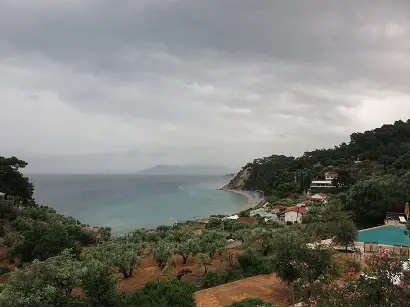The Mediterranean region is fairly dry and has only two seasons, summer and winter. While rainfall is not abundant in the summers, you can expect quite a bit of rainfall in the winter. The question arises, which winds bring rain to the Mediterranean?

The winds that bring rain to the Mediterranean are the north and northwest winds. The north wind blows from the land to the sea, and the northwest wind blows from the sea to the land. These winds pick up moisture from the Mediterranean Sea and carry it over the land.
Read below to know more about the climate of the Mediterranean region and other interesting facts about it.
Rainfall In The Mediterranean Region
Rainfall in the Mediterranean typically comes as a result of the north and northwest winds. These winds are laden with moisture from the Atlantic Ocean, and as they encounter the warm air over the Mediterranean Sea, they release this moisture in the form of rain.
While these winds can occur at any time of year, they are most common in late autumn and winter, when the temperature contrast between the ocean and the land is at its greatest. In addition to bringing rainfall to the region, these winds also help to moderate the climate of the Mediterranean, making it one of the most hospitable environments on Earth.
Thanks to these rains, the region is able to support a diverse array of plant life, including oranges, olive trees, grapevines, and Cypress trees.
In addition to the rainfall resulting from the north and northwest winds, the Mediterranean region can also experience occasional rains from other weather systems, such as thunderstorms, tropical storms, and extratropical cyclones.
How Is The Climate Of The Mediterranean Like?
The climate of the Mediterranean region is characterized by warm, dry summers and cool, wet winters. This distinct seasonal pattern is caused by a combination of factors, including the region’s location in the northern hemisphere and its proximity to large bodies of water.
During the summer months, the Mediterranean Sea acts as a giant heat sink, absorbing solar radiation and releasing it back into the atmosphere. This process helps to moderate temperatures throughout the region, preventing extreme heat waves from developing.
Similarly, during the winter months, the sea helps to moderate temperatures by releasing stored heat back into the atmosphere. As a result, the climate of the Mediterranean region is milder than that of other parts of the world with similar latitudes.
The Mediterranean region is also known for its high levels of precipitation, which are caused by moist air from the Atlantic Ocean being drawn into the area by a subtropical high-pressure system. This moisture results in heavy rainfall during the winter months and occasional thunderstorms during the summer.
What Are Summers and Winters In The Mediterranean Region Like?
The summers are usually dry and humid in the Mediterranean region with little rainfall. The temperature can be expected to be about 50 degrees. While the days are usually hotter, the temperature drops during the night because of cool breezes.
On the contrary, the temperature is between 30 and 65 degrees in winter with higher precipitation. Rainfalls and strong winds may come all of a sudden, paving the way for the vegetation in the Mediterranean region such as sycamore, oak, pine, cypresses, olives etc.
The Mediterranean climate is ideal for those people who feel comfortable in mild weather. The Mediterranean region does not experience autumn and spring, so it may not be for those who prefer a place that has all the 4 seasons.
Who Should Live In The Mediterranean Region?
The Mediterranean Sea has been called the world’s largest swimming pool, and it’s easy to see why. With crystal-clear water and over 3,000 hours of sunshine per year, the Mediterranean is a playground for swimming, sunbathing, and sailing.
The Mediterranean region is considered one of the best locations to live due to its ideal climate and beautiful scenery. The average temperature in the region is between 64-75 degrees Fahrenheit, providing residents with warm summers and mild winters.
This moderate climate is perfect for spending time outdoors year-round, whether it’s enjoying a leisurely stroll along the beach or hiking through olive groves. In addition, the Mediterranean region is home to some of the world’s most stunning landscapes.
From the rolling hills of Tuscany to the dramatic cliffs of the Amalfi Coast, there is no shortage of natural beauty to admire. And while the exact borders of the Mediterranean are debatable, the region is generally agreed to include countries like Italy, Greece, Spain, Morocco, and Turkey.
This diversity is reflected in the food of the Mediterranean, which is characterized by fresh ingredients, simple preparations, and bold flavors. This is the reason why numerous tourists flock to the Mediterranean region each year in search of relaxation and rejuvenation.
Do Rain Storms Happen In The Mediterranean Region?
The Mediterranean region is one of the most geographically diverse places on Earth. It includes parts of Europe, Asia, and Africa, and its climate ranges from temperate to subtropical. However, one thing that all parts of the Mediterranean share in common is a history of rainfall. In fact, rain storms are a common occurrence in the Mediterranean region.
They typically happen in the spring and fall, when warm air from the Sahara Desert meets cold air from the Atlantic Ocean. These collisions can result in heavy rains, strong winds, and even thunder and lightning.
While rain storms can cause some inconvenience, they are also an important part of the region’s ecology. The rains help to replenish the groundwater reserves, which are essential for agriculture and tourism.
Conclusion
The Mediterranean region usually experiences abundant rainfall in the winter season, from the winds that come from the north. The temperatures are not that extreme in the Mediterranean, but one can still expect occasional rain storms, cyclones and thunderstorms. The unique climate of the Mediterranean helps to sustain the natural vegetation in the region and creates an environment that is very attractive to tourists for hiking and trekking.
- The Top Restaurants Specializing in Truffle Dishes - August 10, 2023
- Truffle Panna Cotta: A Decadent Dessert Recipe for Truffle Lovers - August 7, 2023
- Truffle Scrambled Eggs: A Luxurious Breakfast Delight - August 7, 2023








